Whey protein addition to accelerate yoghurt fermentation and facilitate yoghurt structure
Whey proteins were present in appropriate proportion in milk, during heat-treatment
at pasteurization temperatures; whey proteins and casein have the ability to form firm gel of
uniform porosity through heat-induced protein-protein interactions. In this study, the addition of
whey proteins in fresh milk were carry out to investigate whether whey protein would accelerate
yoghurt fermentation time and facilitate the yoghurt structure. The results indicated that the
addition of whey concentrate 80 increased the water retention capacity of the final product.
Whey protein concentrate 80 supplement at the content of 0.8 % shortened fermentation time for
the product 12.5 %. The addition of whey protein also improved the properties of water retention
until 26 %, viscosity and structure of yoghurt products
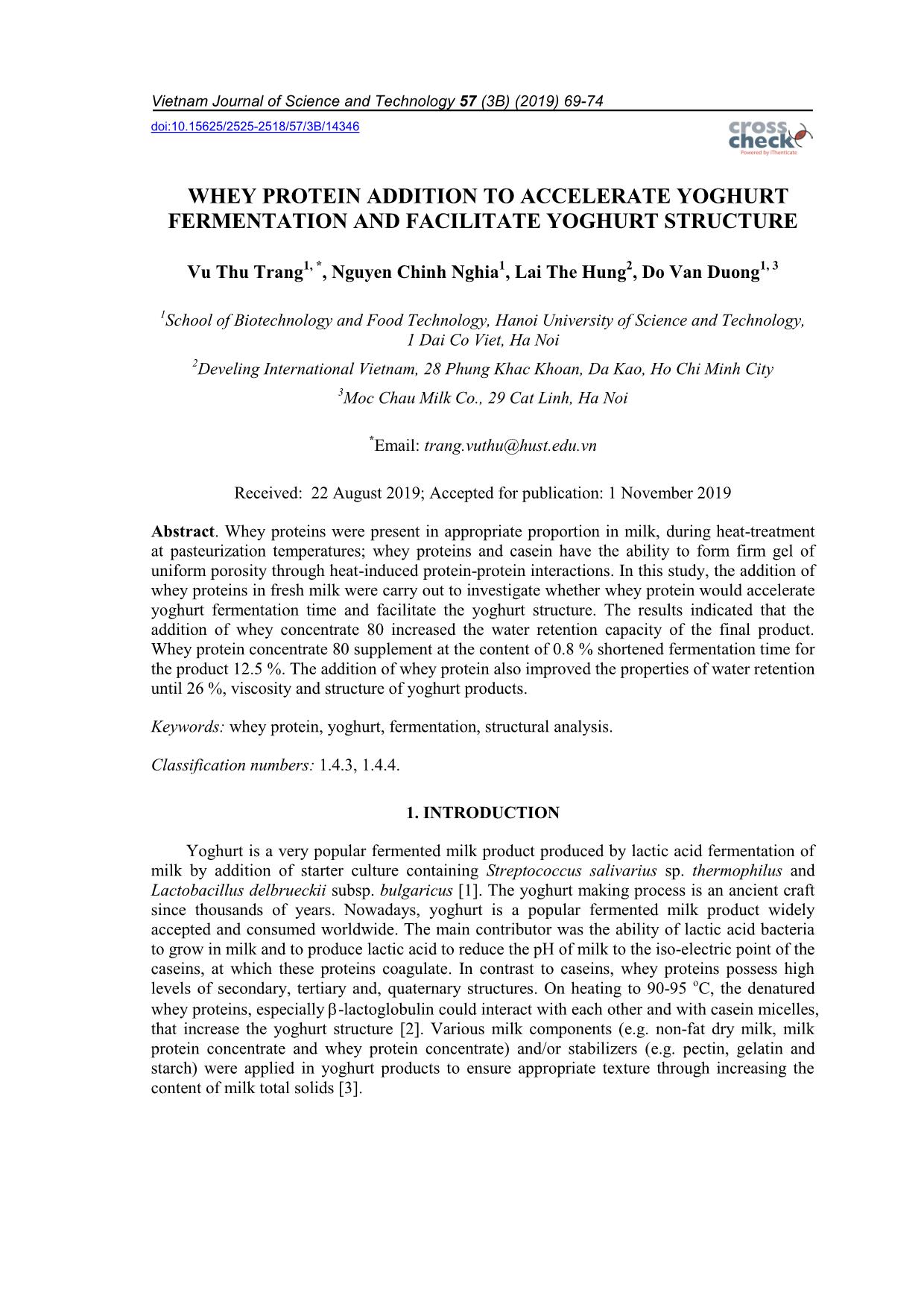
Trang 1
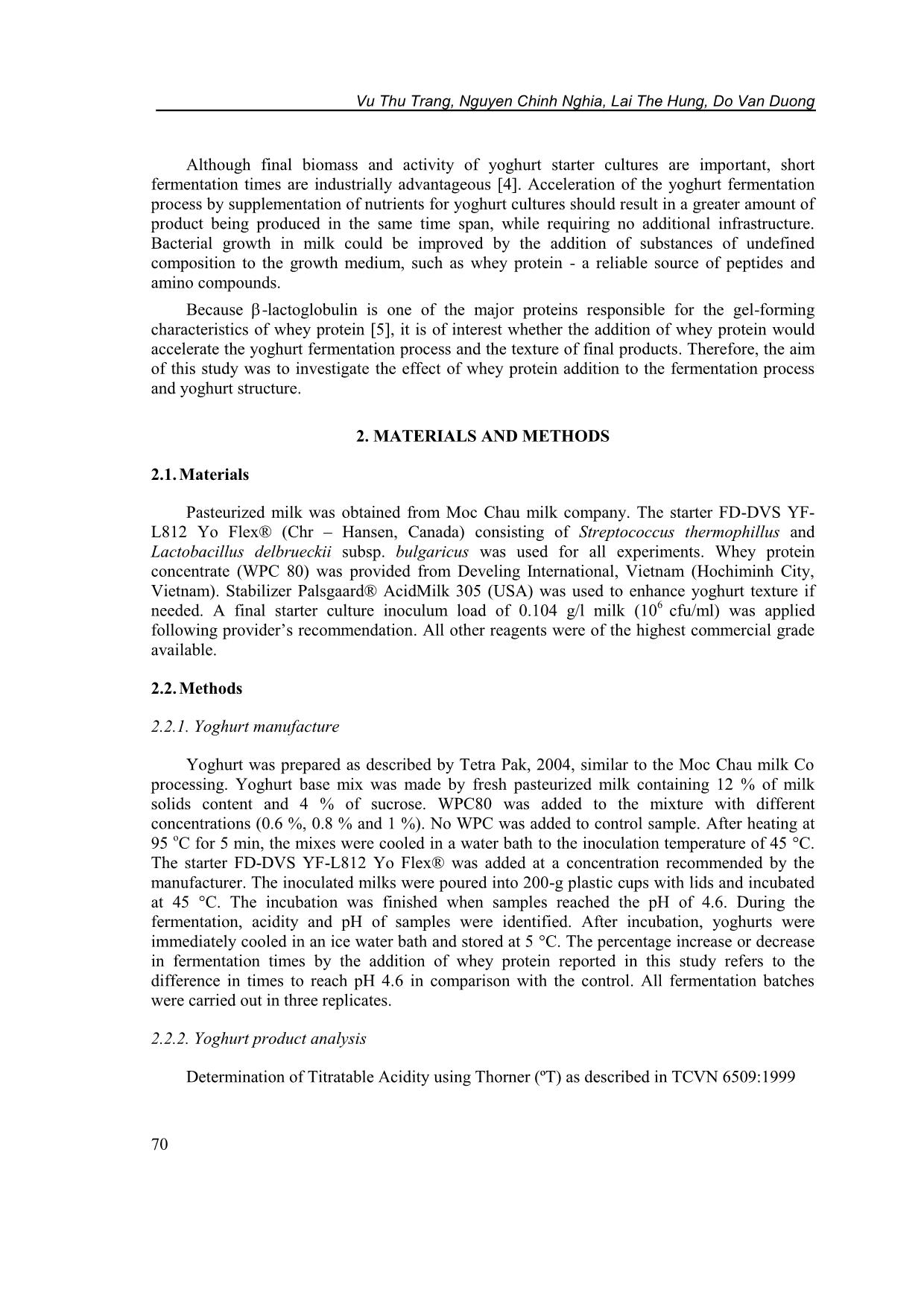
Trang 2
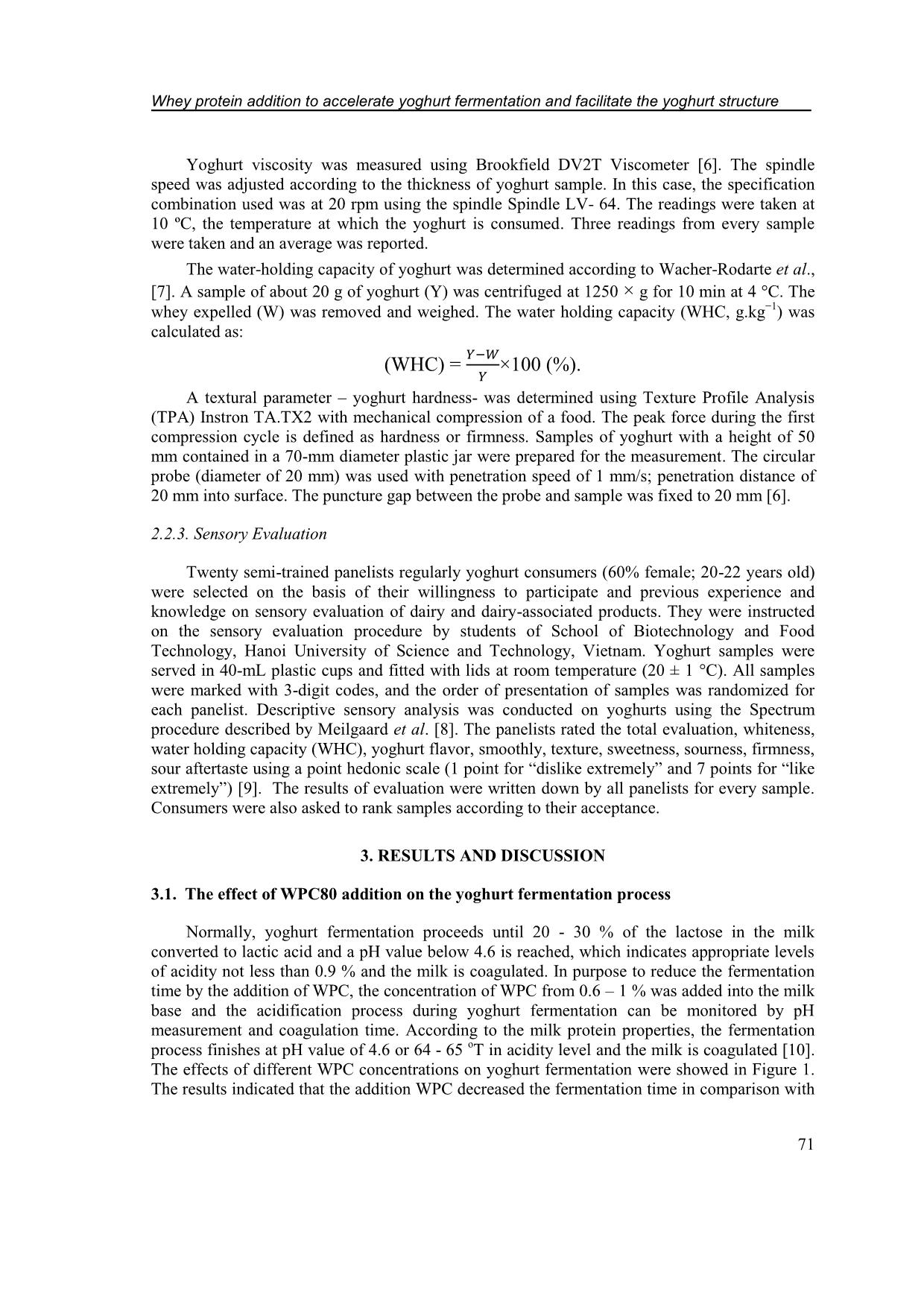
Trang 3
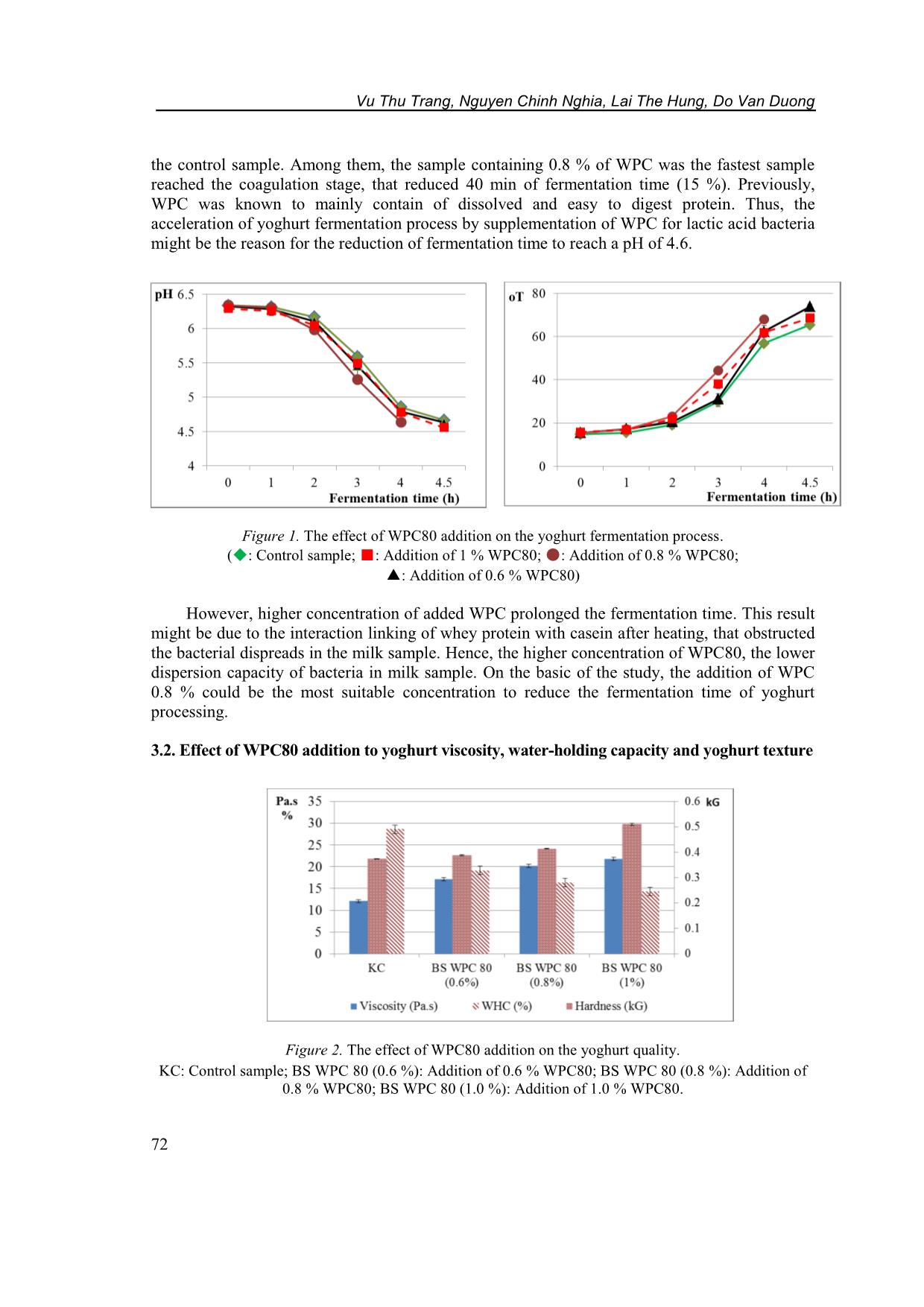
Trang 4
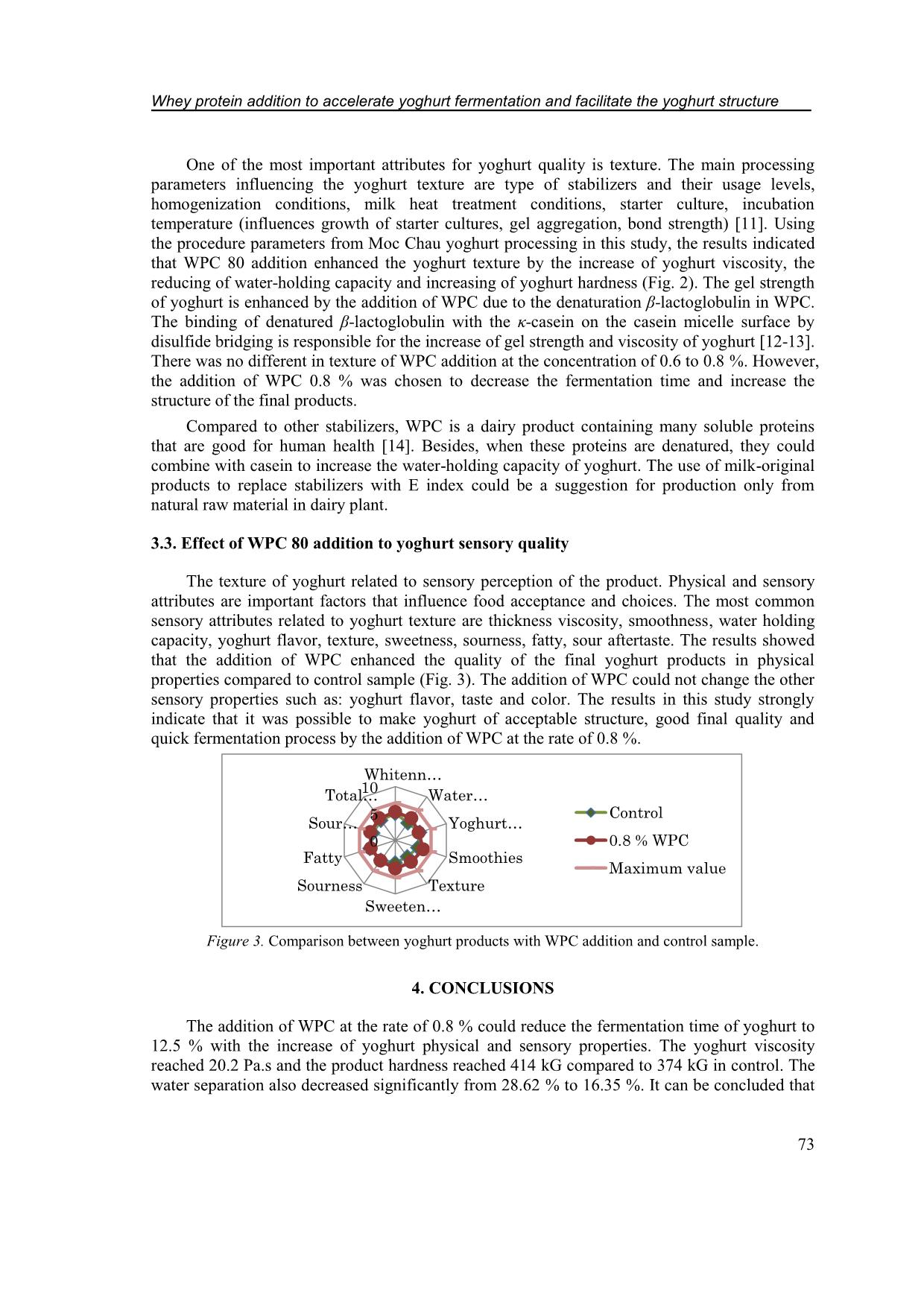
Trang 5
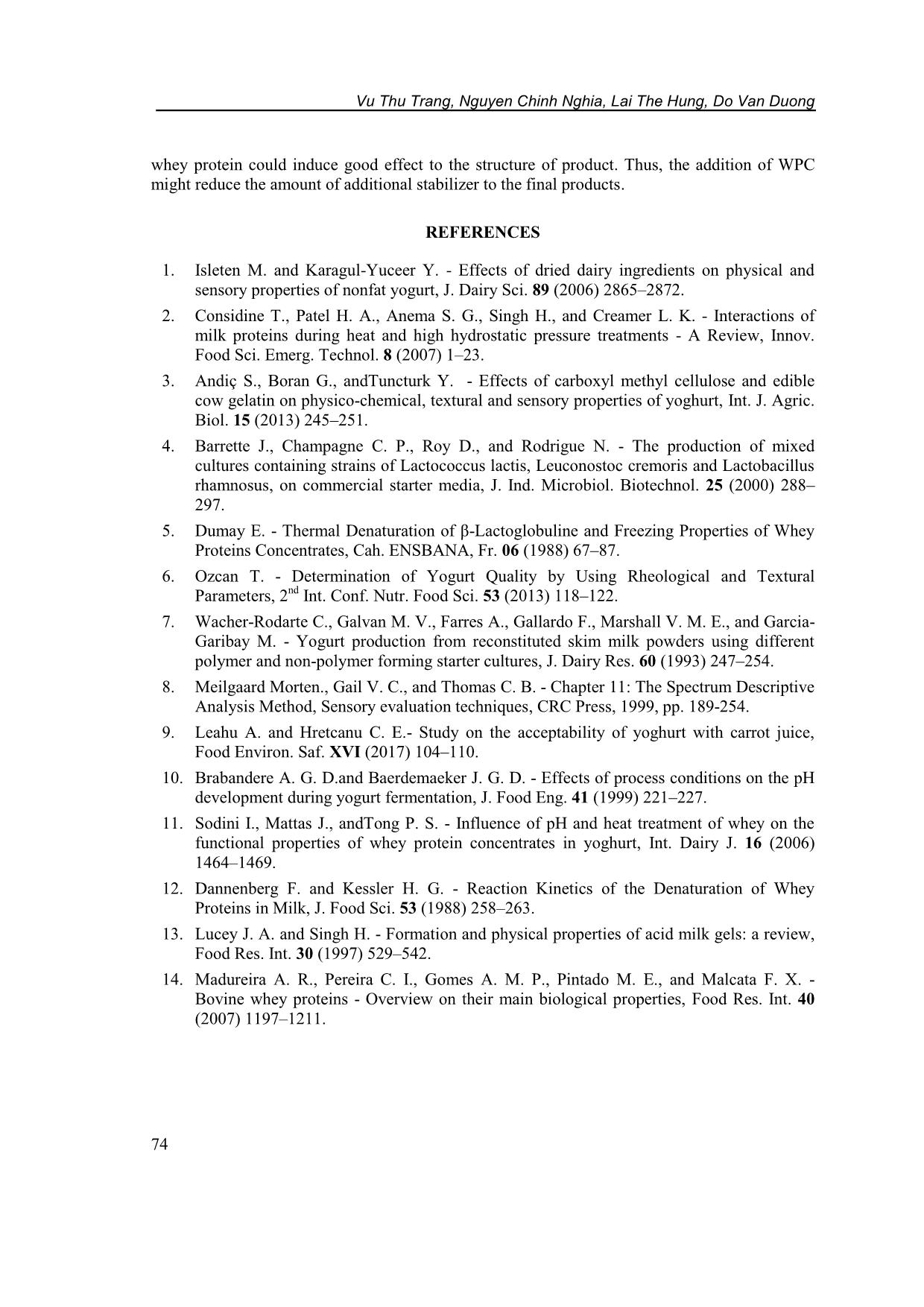
Trang 6
Tóm tắt nội dung tài liệu: Whey protein addition to accelerate yoghurt fermentation and facilitate yoghurt structure
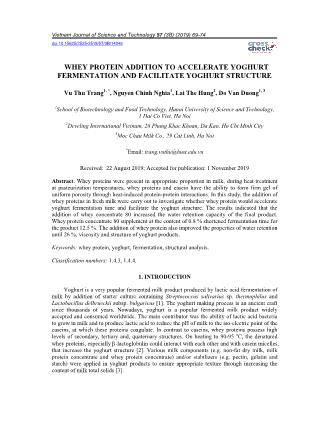
Vietnam Journal of Science and Technology 57 (3B) (2019) 69-74 doi:10.15625/2525-2518/57/3B/14346 WHEY PROTEIN ADDITION TO ACCELERATE YOGHURT FERMENTATION AND FACILITATE YOGHURT STRUCTURE Vu Thu Trang 1, * , Nguyen Chinh Nghia 1 , Lai The Hung 2 , Do Van Duong 1, 3 1 School of Biotechnology and Food Technology, Hanoi University of Science and Technology, 1 Dai Co Viet, Ha Noi 2 Develing International Vietnam, 28 Phung Khac Khoan, Da Kao, Ho Chi Minh City 3 Moc Chau Milk Co., 29 Cat Linh, Ha Noi * Email: trang.vuthu@hust.edu.vn Received: 22 August 2019; Accepted for publication: 1 November 2019 Abstract. Whey proteins were present in appropriate proportion in milk, during heat-treatment at pasteurization temperatures; whey proteins and casein have the ability to form firm gel of uniform porosity through heat-induced protein-protein interactions. In this study, the addition of whey proteins in fresh milk were carry out to investigate whether whey protein would accelerate yoghurt fermentation time and facilitate the yoghurt structure. The results indicated that the addition of whey concentrate 80 increased the water retention capacity of the final product. Whey protein concentrate 80 supplement at the content of 0.8 % shortened fermentation time for the product 12.5 %. The addition of whey protein also improved the properties of water retention until 26 %, viscosity and structure of yoghurt products. Keywords: whey protein, yoghurt, fermentation, structural analysis. Classification numbers: 1.4.3, 1.4.4. 1. INTRODUCTION Yoghurt is a very popular fermented milk product produced by lactic acid fermentation of milk by addition of starter culture containing Streptococcus salivarius sp. thermophilus and Lactobacillus delbrueckii subsp. bulgaricus [1]. The yoghurt making process is an ancient craft since thousands of years. Nowadays, yoghurt is a popular fermented milk product widely accepted and consumed worldwide. The main contributor was the ability of lactic acid bacteria to grow in milk and to produce lactic acid to reduce the pH of milk to the iso-electric point of the caseins, at which these proteins coagulate. In contrast to caseins, whey proteins possess high levels of secondary, tertiary and, quaternary structures. On heating to 90-95 o C, the denatured whey proteins, especially -lactoglobulin could interact with each other and with casein micelles, that increase the yoghurt structure [2]. Various milk components (e.g. non-fat dry milk, milk protein concentrate and whey protein concentrate) and/or stabilizers (e.g. pectin, gelatin and starch) were applied in yoghurt products to ensure appropriate texture through increasing the content of milk total solids [3]. Vu Thu Trang, Nguyen Chinh Nghia, Lai The Hung, Do Van Duong 70 Although final biomass and activity of yoghurt starter cultures are important, short fermentation times are industrially advantageous [4]. Acceleration of the yoghurt fermentation process by supplementation of nutrients for yoghurt cultures should result in a greater amount of product being produced in the same time span, while requiring no additional infrastructure. Bacterial growth in milk could be improved by the addition of substances of undefined composition to the growth medium, such as whey protein - a reliable source of peptides and amino compounds. Because -lactoglobulin is one of the major proteins responsible for the gel-forming characteristics of whey protein [5], it is of interest whether the addition of whey protein would accelerate the yoghurt fermentation process and the texture of final products. Therefore, the aim of this study was to investigate the effect of whey protein addition to the fermentation process and yoghurt structure. 2. MATERIALS AND METHODS 2.1. Materials Pasteurized milk was obtained from Moc Chau milk company. The starter FD-DVS YF- L812 Yo Flex® (Chr – Hansen, Canada) consisting of Streptococcus thermophillus and Lactobacillus delbrueckii subsp. bulgaricus was used for all experiments. Whey protein concentrate (WPC 80) was provided from Develing International, Vietnam (Hochiminh City, Vietnam). Stabilizer Palsgaard® AcidMilk 305 (USA) was used to enhance yoghurt texture if needed. A final starter culture inoculum load of 0.104 g/l milk (10 6 cfu/ml) was applied following provider’s recommendation. All other reagents were of the highest commercial grade available. 2.2. Methods 2.2.1. Yoghurt manufacture Yoghurt was prepared as described by Tetra Pak, 2004, similar to the Moc Chau milk Co processing. Yoghurt base mix was made by fresh pasteurized milk containing 12 % of milk solids content and 4 % of sucrose. WPC80 was added to the mixture with different concentrations (0.6 %, 0.8 % and 1 %). No WPC was added to control sample. After heating at 95 o C for 5 min, the mixes were cooled in a water bath to the inoculation temperature of 45 °C. The starter FD-DVS YF-L812 Yo Flex® was added at a concentration recommended by the manufacturer. The inoculated milks were poured into 200-g plastic cups with lids and incubated at 45 °C. The incubation was finished when samples reached the pH of 4.6. During the fermentation, acidity and pH of samples were identified. After incubation, yoghurts were immediately cooled in an ice water bath and stored at 5 °C. The percentage increase or decrease in fermentation times by the addition of whey protein reported in this study refers to the difference in times to reach pH 4.6 in comparison with the control. All fermentation batches were carried out in three replicates. 2.2.2. Yoghurt product analysis Determination of Titratable Acidity using Thorner (ºT) as described in TCVN 6509:1999 Whey protein addition to accelerate yoghurt fermentation and facilitate the yoghurt structure 71 Yoghurt viscosity was measured using Brookfield DV2T Viscometer [6]. The spindle speed was adjusted according to the thickness of yoghurt sample. In this case, the specification combination used was at 20 rpm using the spindle Spindle LV- 64. The readings were taken at 10 ºC, the temperature at which the yoghurt is consumed. Three readings from every sample were taken and an average was reported. The water-holding capacity of yoghurt was determined according to Wacher-Rodarte et al., [7]. A sample of about 20 g of yoghurt (Y) was centrifuged at 1250 × g for 10 min at 4 °C. The whey expelled (W) was removed and weighed. The water holding capacity (WHC, g.kg −1 ) was calculated as: (WHC) = ×100 (%). A textural parameter – yoghurt hardness- was determined using Texture Profile Analysis (TPA) Instron TA.TX2 with mechanical compression of a food. The peak force during the first compression cycle is defined as hardness or firmness. Samples of yoghurt with a height of 50 mm contained in a 70-mm diameter plastic jar were prepared for the measurement. The circular probe (diameter of 20 mm) was used with penetration speed of 1 mm/s; penetration distance of 20 mm into surface. The puncture gap between the probe and sample was fixed to 20 mm [6]. 2.2.3. Sensory Evaluation Twenty semi-trained panelists regularly yoghurt consumers (60% female; 20-22 years old) were selected on the basis of their willingness to participate and previous experience and knowledge on sensory evaluation of dairy and dairy-associated products. They were instructed on the sensory evaluation procedure by students of School of Biotechnology and Food Technology, Hanoi University of Science and Technology, Vietnam. Yoghurt samples were served in 40-mL plastic cups and fitted with lids at room temperature (20 ± 1 °C). All samples were marked with 3-digit codes, and the order of presentation of samples was randomized for each panelist. Descriptive sensory analysis was conducted on yoghurts using the Spectrum procedure described by Meilgaard et al. [8]. The panelists rated the total evaluation, whiteness, water holding capacity (WHC), yoghurt flavor, smoothly, texture, sweetness, sourness, firmness, sour aftertaste using a point hedonic scale (1 point for “dislike extremely” and 7 points for “like extremely”) [9]. The results of evaluation were written down by all panelists for every sample. Consumers were also asked to rank samples according to their acceptance. 3. RESULTS AND DISCUSSION 3.1. The effect of WPC80 addition on the yoghurt fermentation process Normally, yoghurt fermentation proceeds until 20 - 30 % of the lactose in the milk converted to lactic acid and a pH value below 4.6 is reached, which indicates appropriate levels of acidity not less than 0.9 % and the milk is coagulated. In purpose to reduce the fermentation time by the addition of WPC, the concentration of WPC from 0.6 – 1 % was added into the milk base and the acidification process during yoghurt fermentation can be monitored by pH measurement and coagulation time. According to the milk protein properties, the fermentation process finishes at pH value of 4.6 or 64 - 65 o T in acidity level and the milk is coagulated [10]. The effects of different WPC concentrations on yoghurt fermentation were showed in Figure 1. The results indicated that the addition WPC decreased the fermentation time in comparison with Vu Thu Trang, Nguyen Chinh Nghia, Lai The Hung, Do Van Duong 72 the control sample. Among them, the sample containing 0.8 % of WPC was the fastest sample reached the coagulation stage, that reduced 40 min of fermentation time (15 %). Previously, WPC was known to mainly contain of dissolved and easy to digest protein. Thus, the acceleration of yoghurt fermentation process by supplementation of WPC for lactic acid bacteria might be the reason for the reduction of fermentation time to reach a pH of 4.6. Figure 1. The effect of WPC80 addition on the yoghurt fermentation process. (◆: Control sample; ■: Addition of 1 % WPC80; ●: Addition of 0.8 % WPC80; ▲: Addition of 0.6 % WPC80) However, higher concentration of added WPC prolonged the fermentation time. This result might be due to the interaction linking of whey protein with casein after heating, that obstructed the bacterial dispreads in the milk sample. Hence, the higher concentration of WPC80, the lower dispersion capacity of bacteria in milk sample. On the basic of the study, the addition of WPC 0.8 % could be the most suitable concentration to reduce the fermentation time of yoghurt processing. 3.2. Effect of WPC80 addition to yoghurt viscosity, water-holding capacity and yoghurt texture Figure 2. The effect of WPC80 addition on the yoghurt quality. KC: Control sample; BS WPC 80 (0.6 %): Addition of 0.6 % WPC80; BS WPC 80 (0.8 %): Addition of 0.8 % WPC80; BS WPC 80 (1.0 %): Addition of 1.0 % WPC80. Whey protein addition to accelerate yoghurt fermentation and facilitate the yoghurt structure 73 One of the most important attributes for yoghurt quality is texture. The main processing parameters influencing the yoghurt texture are type of stabilizers and their usage levels, homogenization conditions, milk heat treatment conditions, starter culture, incubation temperature (influences growth of starter cultures, gel aggregation, bond strength) [11]. Using the procedure parameters from Moc Chau yoghurt processing in this study, the results indicated that WPC 80 addition enhanced the yoghurt texture by the increase of yoghurt viscosity, the reducing of water-holding capacity and increasing of yoghurt hardness (Fig. 2). The gel strength of yoghurt is enhanced by the addition of WPC due to the denaturation β-lactoglobulin in WPC. The binding of denatured β-lactoglobulin with the κ-casein on the casein micelle surface by disulfide bridging is responsible for the increase of gel strength and viscosity of yoghurt [12-13]. There was no different in texture of WPC addition at the concentration of 0.6 to 0.8 %. However, the addition of WPC 0.8 % was chosen to decrease the fermentation time and increase the structure of the final products. Compared to other stabilizers, WPC is a dairy product containing many soluble proteins that are good for human health [14]. Besides, when these proteins are denatured, they could combine with casein to increase the water-holding capacity of yoghurt. The use of milk-original products to replace stabilizers with E index could be a suggestion for production only from natural raw material in dairy plant. 3.3. Effect of WPC 80 addition to yoghurt sensory quality The texture of yoghurt related to sensory perception of the product. Physical and sensory attributes are important factors that influence food acceptance and choices. The most common sensory attributes related to yoghurt texture are thickness viscosity, smoothness, water holding capacity, yoghurt flavor, texture, sweetness, sourness, fatty, sour aftertaste. The results showed that the addition of WPC enhanced the quality of the final yoghurt products in physical properties compared to control sample (Fig. 3). The addition of WPC could not change the other sensory properties such as: yoghurt flavor, taste and color. The results in this study strongly indicate that it was possible to make yoghurt of acceptable structure, good final quality and quick fermentation process by the addition of WPC at the rate of 0.8 %. Figure 3. Comparison between yoghurt products with WPC addition and control sample. 4. CONCLUSIONS The addition of WPC at the rate of 0.8 % could reduce the fermentation time of yoghurt to 12.5 % with the increase of yoghurt physical and sensory properties. The yoghurt viscosity reached 20.2 Pa.s and the product hardness reached 414 kG compared to 374 kG in control. The water separation also decreased significantly from 28.62 % to 16.35 %. It can be concluded that 0 5 10 Whitenn Water Yoghurt Smoothies Texture Sweeten Sourness Fatty Sour Total Control 0.8 % WPC Maximum value Vu Thu Trang, Nguyen Chinh Nghia, Lai The Hung, Do Van Duong 74 whey protein could induce good effect to the structure of product. Thus, the addition of WPC might reduce the amount of additional stabilizer to the final products. REFERENCES 1. Isleten M. and Karagul-Yuceer Y. - Effects of dried dairy ingredients on physical and sensory properties of nonfat yogurt, J. Dairy Sci. 89 (2006) 2865–2872. 2. Considine T., Patel H. A., Anema S. G., Singh H., and Creamer L. K. - Interactions of milk proteins during heat and high hydrostatic pressure treatments - A Review, Innov. Food Sci. Emerg. Technol. 8 (2007) 1–23. 3. Andiç S., Boran G., andTuncturk Y. - Effects of carboxyl methyl cellulose and edible cow gelatin on physico-chemical, textural and sensory properties of yoghurt, Int. J. Agric. Biol. 15 (2013) 245–251. 4. Barrette J., Champagne C. P., Roy D., and Rodrigue N. - The production of mixed cultures containing strains of Lactococcus lactis, Leuconostoc cremoris and Lactobacillus rhamnosus, on commercial starter media, J. Ind. Microbiol. Biotechnol. 25 (2000) 288– 297. 5. Dumay E. - Thermal Denaturation of β-Lactoglobuline and Freezing Properties of Whey Proteins Concentrates, Cah. ENSBANA, Fr. 06 (1988) 67–87. 6. Ozcan T. - Determination of Yogurt Quality by Using Rheological and Textural Parameters, 2 nd Int. Conf. Nutr. Food Sci. 53 (2013) 118–122. 7. Wacher-Rodarte C., Galvan M. V., Farres A., Gallardo F., Marshall V. M. E., and Garcia- Garibay M. - Yogurt production from reconstituted skim milk powders using different polymer and non-polymer forming starter cultures, J. Dairy Res. 60 (1993) 247–254. 8. Meilgaard Morten., Gail V. C., and Thomas C. B. - Chapter 11: The Spectrum Descriptive Analysis Method, Sensory evaluation techniques, CRC Press, 1999, pp. 189-254. 9. Leahu A. and Hretcanu C. E.- Study on the acceptability of yoghurt with carrot juice, Food Environ. Saf. XVI (2017) 104–110. 10. Brabandere A. G. D.and Baerdemaeker J. G. D. - Effects of process conditions on the pH development during yogurt fermentation, J. Food Eng. 41 (1999) 221–227. 11. Sodini I., Mattas J., andTong P. S. - Influence of pH and heat treatment of whey on the functional properties of whey protein concentrates in yoghurt, Int. Dairy J. 16 (2006) 1464–1469. 12. Dannenberg F. and Kessler H. G. - Reaction Kinetics of the Denaturation of Whey Proteins in Milk, J. Food Sci. 53 (1988) 258–263. 13. Lucey J. A. and Singh H. - Formation and physical properties of acid milk gels: a review, Food Res. Int. 30 (1997) 529–542. 14. Madureira A. R., Pereira C. I., Gomes A. M. P., Pintado M. E., and Malcata F. X. - Bovine whey proteins - Overview on their main biological properties, Food Res. Int. 40 (2007) 1197–1211.
File đính kèm:
 whey_protein_addition_to_accelerate_yoghurt_fermentation_and.pdf
whey_protein_addition_to_accelerate_yoghurt_fermentation_and.pdf

